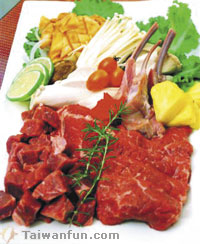
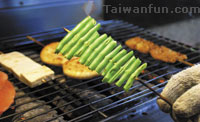
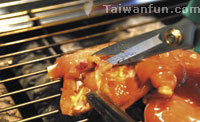
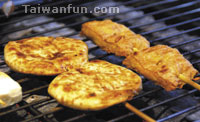
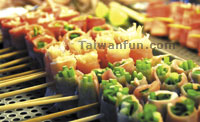
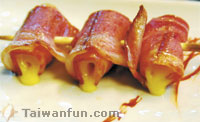
|
Getting creative with your Moon Festival BBQ
Words by Niang Chen Translated by Andy Tsao
With perhaps a hint of autumn breezes in the evening air, Moon Festival is just around the corner. For most Taiwan residents, that usually means it's time to dust off the barbecue grill.
No one really knows when or how it all started, but the Moon, or Mid-Autumn, Festival is no longer just about moon cakes. Having a barbecue during this festive occasion has become almost mandatory and is a sight that can be seen outside of almost every household and/or business on that evening, not to mention many other evenings around the same time. Generally, prepararing barbecue ingredients is quite simple, as BBQ sauces and a variety of meat and vegetables can be easily bought at the supermarket. That being said, Compass Magazine has in this issue consulted with a variety of restaurant and five-star hotel culinary professionals, who have offered a variety of advice, suggested ingredients and recipes for taking your barbecue to the next level with some new flavors this Moon Festival.
Barbecue ingredients
Apart from common meats like ribs, steaks, thin-sliced pork and chicken legs, and seafood like squid, clams, shrimp, mackerel and other fish, there are also BBQ-friendly vegetables such as corn, sweet peppers, peas, cucumbers, eggplant, white bamboo shoots, mushrooms and potatoes. Items like tofu, rice dumplings and even marshmallows are among other popular ingredients. With such a wide variety of vegetables and non-meat ingredients, even vegetarians can have fun barbecuing.
Transforming a home barbecue into a professional one
Mr. Pan of Gulu Gulu Grill Restaurant says that with a top blade steak, also known as a chuck steak, the secret is to remove the layer of tendons before placing the meat on the skewers, which makes it more tender. Pork bought at outdoor markets should go straight into the freezer for about three hours. Then slice it into one-centimeter-thin pieces and tenderize it. It is now ready for cooking and should be grilled until about 70% done before the sauce is brushed on. The end result is tender and juicy.
With chicken breasts, one should avoid the tenderizing process, since it actually breaks up the tissue and causes the loss of the water that keeps the meat tender. In this case, the chicken can go straight to the grill, with sauce added later. When selecting squid, go for the big ones that are thick and elastic. It's unnecessary to remove the membrane; just cut it to pieces from the inside.
When making meat wraps with pork slices and bacon, it's better to select a filling that is long in shape; golden pin mushrooms, asparagus, spring onions and cheese slices are great filling ingredients. A wrap also cooks better when wrapped tightly because the heat gets distributed evenly. A final reminder from Mr. Pan regards the number of times meat should be turned--limit it to a maximum two times so the meat's juices are retained. With vegetables it's advisable to remove them after they're 70% cooked for ultimate freshness. Also be ready with a pair of scissors in hand, to remove burned parts as soon as you possibly can.
Another BBQ expert, the owner of Papa Long restaurant, has additional advice: "Don't put sauces on straight away; leave the meat and seafood to grill and, when they become shiny, that's when you start the turning. To preserve the original flavor of your ingredients, it's sufficient to put the sauce on when they are 70% cooked. It's difficult to thoroughly grill something large like chicken breast. That problem can be solved by making cuts into the meat's surface. However, with processed food like fish balls and tofu, wait until the outside turns golden brown, then apply some sauce and you're ready for serving."
Making sauces with Eastern and Western techniques
Barbecue sauces are mainly used for marinating the ingredients, or enhancing the flavors during grilling. The ingredients which are often used for the sauce in Western cooking are tomato puree, tomato juice, laurel leaf, thyme, rosemary, red onions, black and white peppers, lime juice, lime peels, garlic, ginger, red wine vinegar and others. With the addition of a small amount of red or white wine in particular, you can enjoy some exotic tastes. Another trend in recent years is using beer for marinating meat, as its enzymes and caramel flavor help to enhance flavors.
The common ingredients in Oriental sauces are soy sauce, garlic, satay, cumin, cinnamon, five-spices powder, liquorice powder, multi-spices powder, fish sauce, sesame, chili powder, miso, coriander, spring onions, ginger, vinegar, wine, sugar and so forth. The essence of Asian barbecue sauces centers around various combinations of soy sauce and sugar. Thai-style sauces can also be refreshing options and made to one's own liking with ingredients like fish sauce, sugar, lime juice, coriander, chili, garlic paste, sesame, and rice vinegar. Bear in mind that your personalized sauce recipe can become a very unique blend that no one else has!
Charcoal alternatives for barbecues
As we are living in an era of environmental awareness, most restaurants are now using gas-based fuels with volcanic stones, which radiate infra-red light when heated. The good things about this kind of BBQ set-up and equipment are that it heats up faster, distributes heat more evenly and is easier to control, although it can be challenging to set up. It is economic, eco-friendly, healthier and charcoal-free, and thus recommended by nutritionists like Miss Chow Yun-Shan. If you insist on using charcoal for a better aroma, large Koa wood is highly recommended as it lasts much longer and is of higher quality compared to cheap charcoal, which is unstable and produces ash that easily gets into the food.
|